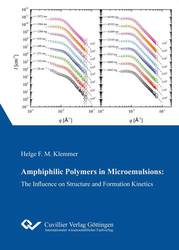| Areas | |
|---|---|
| Serie de libros (96) |
1378
|
| Nachhaltigkeit |
3
|
| Gesundheitswesen |
1
|
| Letra |
2364
|
| Ciencias Naturales |
5406
|
| Matemática | 229 |
| Informática | 319 |
| Física | 980 |
| Química | 1363 |
| Geociencias | 131 |
| Medicina humana | 243 |
| Estomatología | 10 |
| Veterinaria | 108 |
| Farmacia | 147 |
| Biología | 835 |
| Bioquímica, biología molecular, tecnología genética | 121 |
| Biofísica | 25 |
| Nutrición | 45 |
| Agricultura | 1004 |
| Silvicultura | 201 |
| Horticultura | 20 |
| Ecología y conservación de la tierra | 148 |
| Ciencias Ingeniería |
1793
|
| General |
98
|
|
Leitlinien Unfallchirurgie
5. Auflage bestellen |
|
Erweiterte Suche
Amphiphilic Polymers in Microemulsions (Tienda española)
The Influence on Structure and Formation Kinetics
Helge F.M. Klemmer (Autor)Previo
Indice, PDF (49 KB)
Lectura de prueba, PDF (540 KB)
Microemulsions are thermodynamically stable, macroscopically isotropic, nano structured mixtures of at least three components. They excel due to their multifarious nanostructure and ultra low interfacial tension which goes hand in hand with a high solubilisation capacity. Despite their obviously high application potential, they are not appealing for industry, as their formation requires compared to marco emulsions high surfactant loads. About 15 years ago it was found that the solubilization capacity can be strongly increased by the addition of amphiphilic block copolymers. In this thesis the effect of polymers of the structure motive poly(ethylenebutylene) poly(ethyleneoxide) (PEBx PEOy) on oil rich microemulsions and in particular the closed loop was studied. Surprisingly, it was found that the closed loop diminishes through the addition of polymers. Thus, although the polymer increases the solubilization capacity of surfactants strongly, the phase behaviour in the oil rich part of the phase diagram resembles that of microemulsions containing inefficient short-chain surfactants like C6E2. An essential drawback of the polymer addition is the stabilization of various mesophases that cover large parts of the phase space. In this thesis prove was given that newly derived so called tapered diblock copolymers increase the efficiency significantly, while simultaneously suppressing the formation of lamellar phases. Parallel to the elucidation of the influence of amphiphilic polymers on the equilibrium properties of microemulsions, the structural formation kinetics of oil-rich non-ionic microemulsions and the influence of amphiphilic polymers thereupon were studied. Therefore an ultra-fast stopped flow setup was upgraded with the possibility to monitor the formation of microemulsions by transmitted light, scattered light and small angle scattering. Utilizing time resolved small angle neutron scattering measurements it was found that after already 20 ms the microstructure (water in oil micelles) exists and undergoes and aspect ratio change to more elongated micelles resulting in the final microstructure. Detailed analysis of the scattering data revealed that the addition of amphiphilic polymers increases the nevertheless still very fast formation times. Though not all trends observed in neutron scattering could be detected by transmitted and scattered light, in general they confirmed the observed phenomena and formation rates.
Mikroemulsionen sind thermodynamisch stabile, makroskopisch isotrope, nanostrukturierte Mischungen aus mindestens drei Komponenten. Sie zeichnen sich durch ihre vielfältige Nanostruktur und ultraniedrige Grenzflächenspannung aus, die Hand in Hand mit ihrem Solubilisationsvermögen geht. Trotz ihres offensichtlich großen Anwendungspotentials sind sie doch für die Industrie wenig ansprechend, da ihre Bildung im Vergleich zu der der Makroemulsionen große Tensidmengen benötigt. Vor ungefähr 15 Jahren stellte es sich heraus, dass das Solubilisationsvermögen durch die Zugabe von amphiphilen Diblockcopolymeren dramatisch vergrößert werden kann. In dieser Arbeit wurde daher der Effekt von Polymeren des Strukturtyps Poly(ethylenbutylene) – Poly(ethylenoxid) (PEBx – PEOy) auf ölreiche Mikroemulsionen und im Speziellen auf den closed loop untersucht. Überraschenderweise konnte festgestellt werden, dass der closed loop als Folge der Polymerzugabe verschwindet. Obwohl diese Polymere das Solubilisationsvermögen deutlich verbessern, ähnelt hier das Phasenverhalten dem eines kurzkettigen, schwachen Tensides wie C6E2. Einen essentiellen Nachteil der Polymerzugabe stellt die Stabilisierung verschiedener Mesophasen, die einen großen Teil des Phasenraumes überdecken, dar. In dieser Arbeit wurde daher gezeigt, dass neu entwickelte, sogenannte getaperte Diblockcopolymere das Solubilisationsvermögen deutlich verbessern und gleichzeitig die Ausbildung lamellarer Phasen unterdrücken. Parallel zur Aufklärung des Effektes amphiphiler Polymere auf die Gleichgewichtszustände von Mikroemulsionen wurde die strukturelle Bildungskinetik von ölreichen Mikroemulsionen und der Einfluss amphiphiler Polymere darauf untersucht. Hierzu wurde eine überdurchschnittlich schnelle Stopped-Flow Basiseinheit um die Möglichkeit zur Detektion der Mikroemulsionsbildung mittels Durchlicht, Streulicht und Kleinwinkelstreuungstechniken erweitert. Unter Anwendung zeitaufgelöster Kleinwinkelneutronenstreuungsmessungen stellte sich heraus, dass bereits nach 20 ms eine Mikrostruktur (Wasser-in-Öl Mizellen) existiert. Unter Änderung des Radius-zu-Längenverhältnisses wachsen diese dann zu elongierten Mizellen an. Aus einer detaillierten Analyse der Streudaten folgte, dass die Zugabe von amphiphilen Polymeren die trotz allem noch sehr kurzen Bildungszeiten verlängert. Obwohl sich nicht alle in der Neutronenstreuung detektierten Trends mit Durchlicht und Streulicht aufzeigen lassen, bestätigen sich doch alle Methoden im Allgemeinen hinsichtlich der beobachteten Phänomene und der Größenordnung der Zeitkonstanten.
| ISBN-13 (Impresion) | 9783954045587 |
| ISBN-13 (E-Book) | 9783736945586 |
| Formato | B5 |
| Idioma | Inglés |
| Numero de paginas | 296 |
| Laminacion de la cubierta | mate |
| Edicion | 1. Aufl. |
| Lugar de publicacion | Göttingen |
| Lugar de la disertacion | Köln |
| Fecha de publicacion | 18.11.2013 |
| Clasificacion simple | Tesis doctoral |
| Area |
Química
|
| Palabras claves | microemulsion, polymers, surfactants, amphiphile, formation kinetics, solubilization kinetics, SANS, neutron scattering, time-resolved neutron scattering, stopped-flow experiments, light scattering Mikroemulsion, Polymere, Tenside, Amphiphile, Bildungskinetik, Solubilisationskinetik, SANS, Neutronenstreuung, zeitaufgelöste Neutronenstreuung, Stopped-Flow Experimente, Lichtstreuung |








